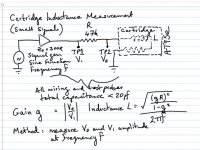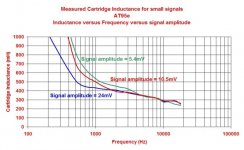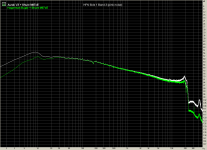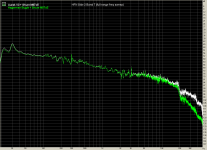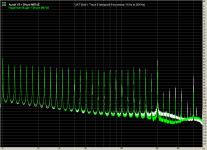I didn't find any threads there.
Also, I am not going to spend $33 to find out if you wrote something that may or may not be useful to me.
In addition, it would be interesting to hear why you refer to FIRs as evil. They seem to have their uses.
At some level he speaks from the days of first generation DSP's and processors with limited power. In doing research I came across numerous references for preserving resolution with 16 bit DSP's and things like that. Technology has moved too fast, much even from the late 90's is just intellectual curiosity now.
I was mulling this, mainly as in the early days of GSM DSP was expensive and a lot of angst was spent on ASIC vs DSP balance. And Xylinx loved us. But that was a world where you would implement digital filtering on a diddy fpga that would book and be ready for action in fractions of a second. The frankly boggling mips that a few $ buys these days means that almost anything want to use has an operating system which takes an age in comparison*. There is a plethora of hardware that can do what I want but a lot of it is horribly clanky although cheap. MiniDSP is great but limited in what you can do (only 4 pre-sets unless you keep a laptop hooked up).
Maybe we lost something between the 90s and today
*Marantz CD80 ready to play in under 5 seconds. Pioneer bluray from 2015 about 40 seconds from power on to being able to load a bluray then another 30 seconds to read the disk. Oh and runs Java!
Maybe we lost something between the 90s and today
*Marantz CD80 ready to play in under 5 seconds. Pioneer bluray from 2015 about 40 seconds from power on to being able to load a bluray then another 30 seconds to read the disk. Oh and runs Java!
Probably, today if I wanted to try digital RIAA filtering, I would be inclined to try it using VST plugins. It would easy to try different filter types and compare them with listening tests, along with any other desired testing. If I found something that I preferred, then I might try to see if I could match or better that sound quality with a mini-DSP, or other dedicated solution.
Similarly, I would want to try it with my best data converters first, to set some point of reference. After that, it would be interesting to see how close I could come with a dedicated solution.
It could be that I would choose to stick with my PC to do the processing. After all, I rely on it for playing music in other ways. Don't see why this would need to be an exception.
Similarly, I would want to try it with my best data converters first, to set some point of reference. After that, it would be interesting to see how close I could come with a dedicated solution.
It could be that I would choose to stick with my PC to do the processing. After all, I rely on it for playing music in other ways. Don't see why this would need to be an exception.
Your case is certainly not an exception, just a different use case to mine. When I spin a record I don't want to have to have a PC running and a screen on. miniDSP allows that within its limitations so is a closer match to my needs. If I could afford a better converter (or when) I can use those with it. Win win. But it falls apart when you go from test records and adjusting for best FR to adjusting to taste or even shock horror adjusting for recording/mastering faults. In this case the much lusted after Cello Palette was about the only thing that had a good user interface so I think that will remain a pipe dream unless I come up with std EQs for certain labels/ranges. This is the problem with digital eq. The sky is the limit so you fall down a rabbit hole. But we are in the 21st century and defeatable tone controls should no longer be something to be ashamed of 🙂
If I were setting up a study system them I would let the PC take the strain of course. But I don't have a study and no room for a turntable to be used in the man cave as all space taken up with projects.
For something different, listen to the samples from this album BIS Records - Das Wohltemperierte Akkordeon . It's so wrong it's almost right !
If I were setting up a study system them I would let the PC take the strain of course. But I don't have a study and no room for a turntable to be used in the man cave as all space taken up with projects.
For something different, listen to the samples from this album BIS Records - Das Wohltemperierte Akkordeon . It's so wrong it's almost right !
Probably, today if I wanted to try digital RIAA filtering, I would be inclined to try it using VST plugins.
Most VST plug-ins I've seen for RIAA are just IIR bi-quads. Two bi-quads even do 44.1kHz rate to ridiculous accuracy and on a PC everything is double precision so all the numerical issues are just ancient history.
even the meaning of double has evolved - 64 bits in either float or int should be adequate for even tone arm resonance filtering with IIR @192k - but 32 bit 'doubles' may not
biQuads do seem to be the practical winner too - higher order IIR have stability issues
biQuads do seem to be the practical winner too - higher order IIR have stability issues
even the meaning of double has evolved - 64 bits in either float or int should be adequate for even tone arm resonance filtering with IIR @192k - but 32 bit 'doubles' may not
biQuads do seem to be the practical winner too - higher order IIR have stability issues
Still out of curiosity I would like to compare Richard's version of impulse invariance. It is a completely different approach with it's own set of problems like potential aliasing and stability. The stability criterion for bi-quads is pretty cut and dry.
As to one of Richard's comments, for the 75us time constant at 44.1kHz the bilinear transform is actually pretty far off at 20k.
Last edited:
What does any of this have to do with the thread topic ?
Can't you guys take it outside........there are plenty of threads that cover this and if you don't agree then why not start one ?
LD
Can't you guys take it outside........there are plenty of threads that cover this and if you don't agree then why not start one ?
LD
What does any of this have to do with the thread topic ?
When we determine the net equalization, all digital is a viable alternative. Rather than a different pre-amp for each cartridge? No problem though we should get there first.
Last edited:
Let's take it to George's Digitising Vinyl thread as it appears most of the contributors are already there.Can't you guys take it outside........there are plenty of threads that cover this and if you don't agree then why not start one ?
Can't you guys take it outside........there are plenty of threads that cover this and if you don't agree then why not start one ?
I've got some beach bum issues to deal with this Easter so might be a bit slow in answering some of the many good points raised .. which are in fact all in SAI.
I've been asked to put it in JAES .. mainly I think cos I wrote it as a sorta IIR/FIR tutorial ... but as you can see ... its 9 yrs later and its still not there. Beach bums have a very elastic concept of time 🙂
Last edited:
Well, indications are that there's far more to what's at issue than straightforward eq. For example, cantilever propagation might be significantly dispersive, and coil losses might well be significantly level/slew rate sensitive.........When we determine the net equalization, all digital is a viable alternative.
No doubt there might be viable digital solutions, but methinks the nature of any 'correction problem' has to first be properly understood. Or, if one has to compromise, even 'vaguely understood' 😉
It's very probable that vinyl playback can have level and slew rate sensitive eq, and separately phase, 'correction' requirements. Strictly.......
Apart from being part of the charm and sound of vinyl playback, philosophically it's better to avoid the artefacts at source if at all possible, I figure.
LD
Last edited:
It's very probable that vinyl playback can have level and slew rate sensitive eq, and separately phase, 'correction' requirements. Strictly.......
Can you elaborate on this Lucky?
George
Let's take it to George's Digitising Vinyl thread as it appears most of the contributors are already there.
Sounds good to me, I'd like to work through some real examples though you should realize the latency stuff is a total don't care for anything I'm interested in.
For sure.Can you elaborate on this Lucky?
George
A few years back I made tests similar to yours, George, because it seemed to me that cartridge inductance could apparently behave as though it varied with programme level.
Attached is a sketch of the method, which I think you can see is similar to your setup, using a generator to provide drive for a cartridge coil, and I effectively measured coil impedance. Which, being just a pup, I assumed to be inductive.
Also attached are two sets of measurements for an AT95 cartridge coil measured this way, which does strongly suggest that coil impedance is a function of level.
With hindsight I was naïve in modelling the cartridge as a simple inductance, and it raised more questions than answers at the time. So I find your own results and Hans' model very interesting, and would be fascinated to explore whether your results might vary with level. I predict they will, and the model needs to accommodate this !
LD
Attachments
With hindsight I was naïve in modelling the cartridge as a simple inductance, and it raised more questions than answers at the time. So I find your own results and Hans' model very interesting, and would be fascinated to explore whether your results might vary with level. I predict they will, and the model needs to accommodate this !
LD
Luck, what's the starting model that captures the change of L with frequency, or are you not taking into account the phase? You really need to separate real and imaginary parts of g.
You really need to separate real and imaginary parts of g.
Yes. I agree. An impedance sweep (phase and modulus vs freq) will provide these and give hindsight.
I have done it at one signal level. I am planning to work further on this.
The apparent inductance changes you show Lucky are very serious.
My understanding is that what really changes is the eddy current loss and magnetic hysteresis loss.
But these will account to a lesser degree of the effect that Lucky shows.
Also I don't know what experiment will help to discriminate btn these two (eddy current and hysteresis losses).
I think we have to call jneutron
George
Hmm This could be the point where I remind LD I have a SuperOM with his name on it. This could possible add another point in the data. The main difference between OM and super is split pins which in theory stop eddy currents. So you should be able to measure a difference between the two families.
In other news the penny finally dropped on something that had been bothering me over transimpedance amplifiers thanks to the late, great Bob Pease. Now a load of the stuff Hans has been saying finally makes sense. Now I'm just confused over the best way to do a FET/opamp hybrid for when I need lowest noise. The LT data sheets show a single ended solution, others use a FET diff pair. I'll get there given another month or two!
In other news the penny finally dropped on something that had been bothering me over transimpedance amplifiers thanks to the late, great Bob Pease. Now a load of the stuff Hans has been saying finally makes sense. Now I'm just confused over the best way to do a FET/opamp hybrid for when I need lowest noise. The LT data sheets show a single ended solution, others use a FET diff pair. I'll get there given another month or two!
Yes, I think you are very probably right, George.My understanding is that what really changes is the eddy current loss and magnetic hysteresis loss
With hindsight, that stuff of mine from a few years back was pretty naïve, but I think there probably is something to it that coil impedance as a 2 pin network can change significantly with level.
IMO it would be very interesting if you are able to repeat your tests at more than one level representative of realistic cartridge drive levels, now that your TI preamp and test rig are available, George.
LD
Per audience request
Playing test records
Aurak V3 (OPA2134, NE5532)
vs
Hagerman Bugle (3xOPA2134)
SHURE M97xE on Kenwood KD-3100 with a typical S tonearm.
Cartridge to preamplifier wiring:100pF
The Hi-FI News 002 Test LP (HFN)
Side 1 Band 3 (pink noise)
Side 2 Band 7 (full range freq sweep)
The Ultimate Analog Test LP (UAT)
Side 1 Track 6 (1KHz-20KHz stepped freq sweep)
Side 2 Track 2 (pink noise)
All 24b/96KHz recordings level matched at 1KHz to +/- 0.1dB
George
Playing test records
Aurak V3 (OPA2134, NE5532)
vs
Hagerman Bugle (3xOPA2134)
SHURE M97xE on Kenwood KD-3100 with a typical S tonearm.
Cartridge to preamplifier wiring:100pF
The Hi-FI News 002 Test LP (HFN)
Side 1 Band 3 (pink noise)
Side 2 Band 7 (full range freq sweep)
The Ultimate Analog Test LP (UAT)
Side 1 Track 6 (1KHz-20KHz stepped freq sweep)
Side 2 Track 2 (pink noise)
All 24b/96KHz recordings level matched at 1KHz to +/- 0.1dB
George
Attachments
Now I'm just confused over the best way to do a FET/opamp hybrid for when I need lowest noise.
Several of us have beaten that one to death.
- Home
- Source & Line
- Analogue Source
- mechanical resonance in MMs
